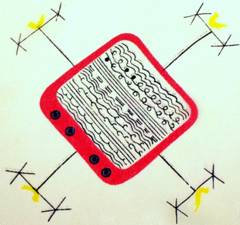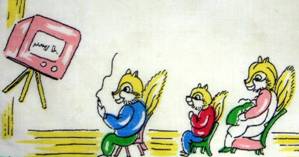
Westinghouse, Motorola, Philco, Zenith, General Electric, RCA, Sylvania, Magnavox, Admiral… all were household names during the golden age of television. No invention has ever been more quickly embraced by the American public. Before 1947, only a few thousand homes had TV; by 1955, over half of all U.S. homes had television. (Faster than the growth of telephones, computers or the internet!) By the late 1990’s, 98% of homes had at least one TV, and those sets were turned on an average of more than seven hours a day. No wonder advertisers viewed TV as the most efficient, wide reaching and sustainable avenue to influence a captive audience.
“Seeing a murder on television…can help work off one’s antagonisms. And if you haven’t any antagonisms, the commercials will give you some.”
Alfred Hitchcock
You might be surprised to discover the first television was designed by a 21 year old inventor who lived in a house without electricity until he was 14! Others had made attempts to transmit images, but Philo Farnsworth’s invention, based on beams of electrons, is the ancestor of our modern television, first demonstrated in 1927 in San Francisco. Now we watch shows in the palm of our hand on ipads and smart phones, so it seems we’ve come full circle since the days when the first TV screens were 5” x 12”.
Isn’t it ironic one can sit in front of a TV today with 500+ stations and lament “There’s nothing to watch.” Far from being a ‘boob toob’ or ‘babysitter’ early TV delivered on the networks’ promise to entertain and inform. From its inception, television delivered dramatic shows worthy of our attention – Kraft Television Theatre (1947), Studio One (1948), Playhouse 90 (1956), and the U.S. Steel Hour (1953). This was known as the Golden Age of television.
Handkerchiefs from that era reflect a range of entertainment most had heretofore never seen via live performance – opera, symphony, ballet, theatre, and more…

From Paderewski to Pagliacci, television provided a cultural banquet of riches.
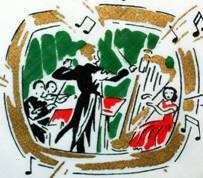 |
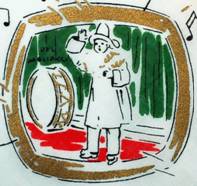 |
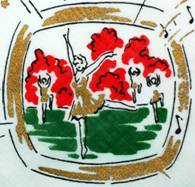 |
“No great television show has ever rested on just one person.
They’re all about great ensembles and storytelling.”
Justin Kirk
| Note the massive broadcast tower dominating the handkerchief above. Initially TV had to wrest bandwidth from the jaws of radio. To appreciate the power of radio during that era, think of Franklin Roosevelt’s ‘fireside chats’ or Orson Welles’ 1938 War of the Worlds. With the advent of television, entertainment came to life in a whole new dimension. In this playful Tom Lamb children’s handkerchief, a silly duck broadcasts on QUAK. | 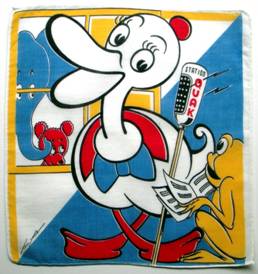 |
The Triple Thrill? According to these gals in opera gloves, it’s Radio, TV, and a Phonograph, all housed in a custom cabinet – Whooeee . For those who think home shopping to be a recent permutation, here’s a 1948 ad to set the record straight. TV could be both glamorous and practical, entertaining and functional.
 |
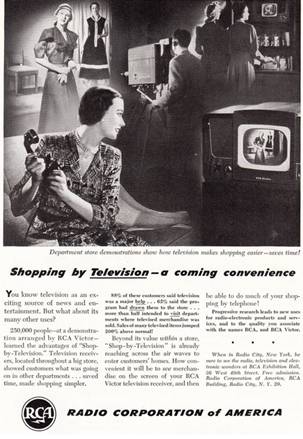 |
Along with great drama, audiences craved comedy. The hands down favorite? I Love Lucy. In 1953, after being on air for less than a year, Lucille Ball signed a contract for 8 million dollars, the largest TV contract ever written at that time. More people watched Lucy on Monday nights than had watched the inauguration of President Eisenhower.
 |
As we learned in Saddle Up Cowboy, westerns were hugely popular at the time – Hopalong Cassidy, Roy Rogers, Gunsmoke, The Rifleman, etc. as well as thrillers – Twilight Zone, Alfred Hitchcock, crime and detective stories – Dragnet, Perry Mason, family oriented shows – Father Knows Best, Leave It To Beaver, variety hours like Ed Sullivan, and numerous game and quiz shows, where Johnny Carson got his start. Handkerchiefs showcased the broad spectrum of entertainment this exciting new medium provided. |
“An intellectual snob is someone who can listen to the William Tell Overture and not think of The Lone Ranger.”
Dan Rather
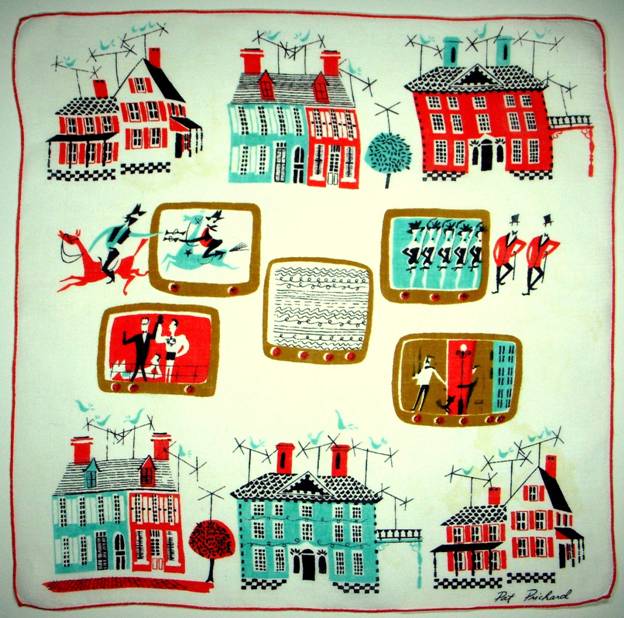
Note the forest of antennae protruding from every rooftop, along with the indecipherable TV screen in the middle. Reception was not what it is today, and a sudden thunderstorm could maddeningly wipe out everything from the Boston Symphony to Howard Cosell’s staccato report of the Saturday Night Fight.
The same artist does a second take on silk crepe, this time, including sports, like those famous fights as well as the Kentucky Derby. The June Taylor dancers compete with rollicking musicians for audience applause. Dig that crazy TV in the center, reminiscent of the Russian satellite Sputnik launched in 1957.
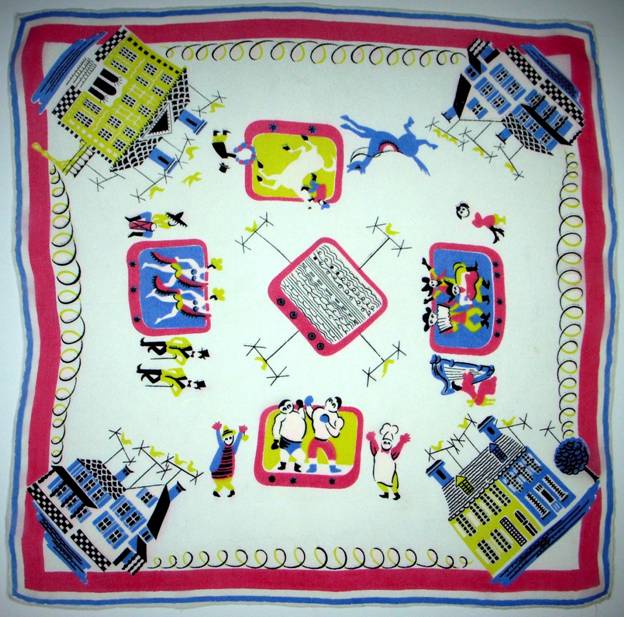
“When you’re young, you look at television and think, there’s a conspiracy. The networks have conspired to dumb us down. But when you get a little older, you realize that’s not true. The networks are in business to give people exactly what they want.”
Steve Jobs
 |
|
This one’s a mind bender. Home TV repair? No wonder he looks miffed. It never ceases to amaze me what people chose to illustrate on a handkerchief…
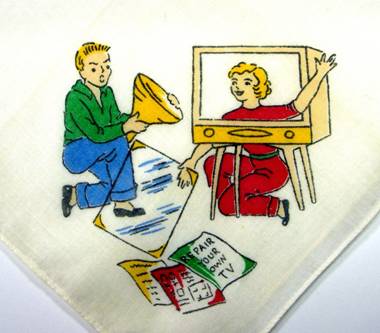
My favorite, the pièce de résistance, this hankie has it all.
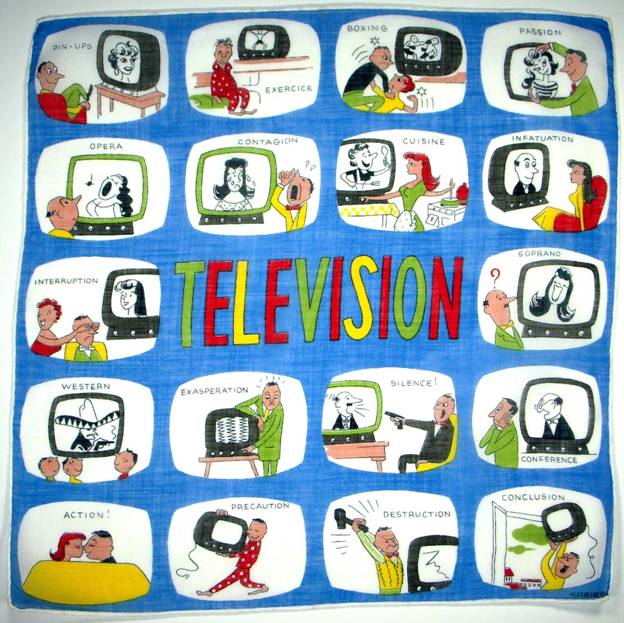
“Television characters live inside our minds as though they’re actual people. In fact, we know more about them then we do about most people in our physical lives.”
Neal Pollack
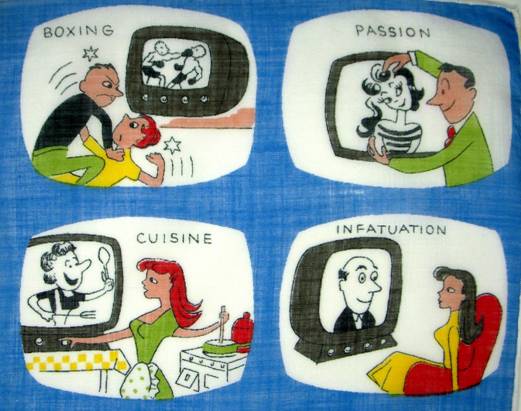
“What the mass media offers is not popular art, but entertainment which is intended to be consumed like food, forgotten, and replace by a new dish.”
W.H. Auden, The Dyer’s Hand
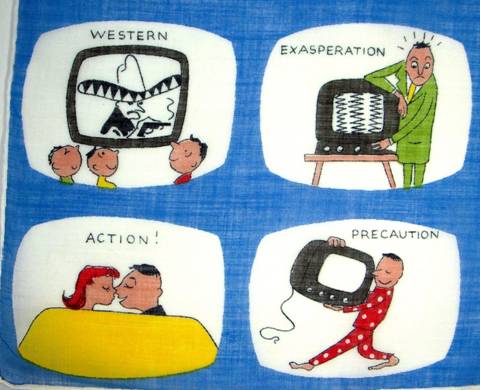
Dad rushed home from work to relax in his TV chair and view a variety of entertainment. A special treat for kids was to leave the dinner table to watch a show. Pre-packaged TV dinners became a hit with busy moms, as they purchased sets of tray tables to accommodate this new lifestyle. Television quickly assumed center stage in the home, and for many has remained there.
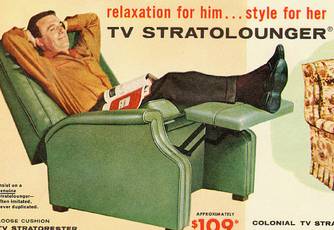 |
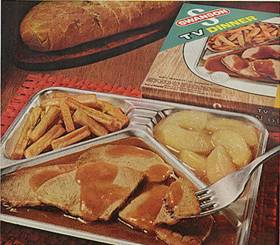 |
Furniture…meals… could toys be far behind? It’s impossible to overstate how American became consumed with television. When NBC aired Peter Pan starring Mary Martin in 1955, the show garnered an astounding 60 million viewers. (Note it’s featured in the game below.) meaning nearly every home that had a television was tuned in to Peter Pan. Yowsa. The Super Bowl pales in comparison….
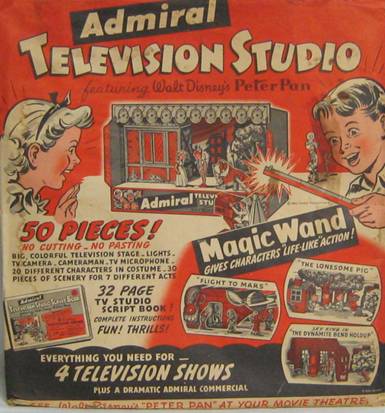
Truth be told, most of us have a love/hate relationship with the tube, it’s so addictive. But love it or hate it, television has changed our lives forever. If you bemoan the fact, like Frank Lloyd Wright, that it’s “chewing gum for the eyes”, you haven’t tuned in to PBS. TV provides a bounty for the taking – from the finest in entertainment, to the thrill of Olympic competition, to mourning with a country when its leader dies. Television has allowed us to see the horror of war in real time, prompting people to lobby their congressmen, as well as watch the first man walk on the moon, which for many, may be the only chance in our lifetime we’ll ever witness such an event.
“Thanks to television, for the first time the young are seeing history made before it is censored by their elders.”
Margaret Mead
When bedridden with the flu, too fuzzy headed to read, I welcome the solace of TV to fill those sleepless hours with movies I can get lost in. On other occasions, witnessing the noble actions of others across the globe I’m inspired to take action myself. Television is neither angel nor demon, but what you make of it, as these handkerchiefs so clearly remind us.
Just for Fun
How many of these Golden Oldie TV show theme songs can you recognize?
Quiz
Questions are presented in chronological order, to correlate to events in history, and in order to help you.
- How many hours does the average American spend watching TV daily?
- Who was the first president to appear on television?
- When was the first televised baseball game? What teams played?
- What was unique about the make-up worn on early television?
- Where did the term “anchorman” originate?
- When was the first indication that television could have a strong impact on politics?
- When and what was the first national broadcast in color?
- What show was considered the first realistic/true-to-life sitcom?
- When was the birth of PBS?
- When did high definition TV first appear?
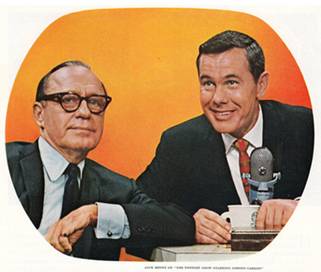
Answers
- 2.5 to 5 hours
- FDR was the first president to appear on TV in a 1939 RCA broadcast of the opening of the New York World’s Fair.
- May 17, 1939 a mobile unit captured the first baseball game between Princeton and Columbia Universities.
- Due to the extremely bright lights required for capturing images, early television had difficulty registering the color white, thus actors were required to wear black lipstick and green makeup.
- It is believed Walter Cronkite was the first newscaster to be referred to as an “anchorman” when he covered the first presidential nominations to be televised in 1952.
- During the 1960 presidential debate between John F. Kennedy and Richard M. Nixon, those who listened to the debate on radio declared Nixon had won; those who saw the debate televised declared Kennedy the victor. Apparently the charm and charisma conveyed visually trumped what was said by the candidates.
- The Tournament of Roses parade was the first event to be nationally broadcast in color in 1964. On June 25, 1951, CBS broadcast the first color TV program, but most people couldn’t watch it on their black and white TVs. It was a show called Premiere starring Ed Sullivan, Arthur Godfrey, Sam Levenson and others. It only aired in four cities.
- Critics claim CBS’s All in the Family (1971-1979) was the first realistic sitcom.
- You might be surprised to learn that Congress created PBS in response to a 1967 Carnegie Commission report recommending the creation of a non-commercial, nonprofit educational Network.
- HDTV was first available in 1998.
The antique German copper plate at the start of this blog is a monogramming template for table linens, bed linens and handkerchiefs. “TV” actually represents someone’s initials.
Thanks to Grolier’s History of Television and to Mitchell Stephens, NYU for much of the information found in this blog.
Well, ok, may as well toss in the William Tell Overture as well.
